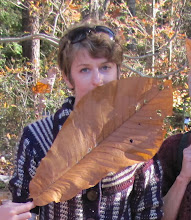White Sands National Monument sits at the northern end of the Chihuahuan Desert in the Tularosa Basin. The gypsum dunes encompass 275 square miles of desert and are the largest gypsum dune field in the world and one of the world's natural wonders. Gypsum isn't usually found as sand as it is soluble in water, however no river drains the basin in which White Sands sits, trapping it in the desert climate as sand.
I took a couple short hikes, the first a 1 mile trail in the ecotone between the Chihuahuan Desert, speckled with shrubs and cactus and small trees, and the nearly barren gypsum sands that glisten with the sun for miles. I saw different little animal tracks near the trail, not really identifying them, probably beetles, but I did recognize the tracks of a pocket mouse. Most of the dune creatures have evolved to become as white as their surroundings, including the little mouse, but they usually rest in the shade in the heat of the sun.
I followed the road into the center of the dune field and walked along another trail. I veered off, always aware of the trail, since it is easy to get lost in the white expanse, took off my shoes and walked up a tall dune. The sand wasn't hot like that found at the beach, but cool, and I dug my toes into the sand. The dunes seemed to dampen any sound that might otherwise carry, and it was refreshingly quiet of any modern day sounds. Finally, I put my shoes back on and hit the road again.
Saturday morning I headed into Carlsbad Caverns National Park, also in New Mexico. This park is also in the Chihuahuan Desert but in the Guadalupe Mountains. Heading in, the desert and mountains were something I had been seeing for hundreds of miles, and I wasn't totally impressed but I knew the caverns lurked beneath the surface. I walked down the switchbacks into the Natural Entrance, dark and ominous. The patch was paved and once in the depths, which would normally be pitch-black, there were small lights placed behind the speleothems casting dim light and shadows across the walls. It was incredibly mysterious, the air was cool and damp and smelled a bit stale. My heart beat a bit faster, not because it was strenuous, but because it was exciting. I imagined what it was like to be one of the first explorers, heading into the cave blind (no map, no path, no lights), not knowing when the cave might fall away into a pit (which do exist there).
 Ansel Adams described Carlsbad Cavers as "...something that should not exist in relation to human beings. Something that is as remote as the galaxy, incomprehensible as a nightmare, and beautiful in spite of everything."
Ansel Adams described Carlsbad Cavers as "...something that should not exist in relation to human beings. Something that is as remote as the galaxy, incomprehensible as a nightmare, and beautiful in spite of everything."I walked the 2 miles through the Main Corridor and into the Big Room, winding around columns and stalagmites, under stalactites and soda straws peppered with popcorn (yes, these are all terms of speleothems, not just items at the movie theater). I had never seen anything quite like this. It was quiet in the caverns, but if another tourist commented about the rocks in anything above a whisper, if echoed through the cave. Back on the surface, the sun was bright and the air was hot.
I drove as long as I could that afternoon because I had made the decision to skip my exploration of Texas and to drive the 1000+ miles home to the Mississippi Gulf Coast. I was tired and not feeling well and as I said before, getting frustrated with the endless unpacking and packing of the car every day. And I'll still head to Texas in a few weeks to visit Anita in Houston.
(click here to see more photos from my 2 week long, 4000 mile road trip)








